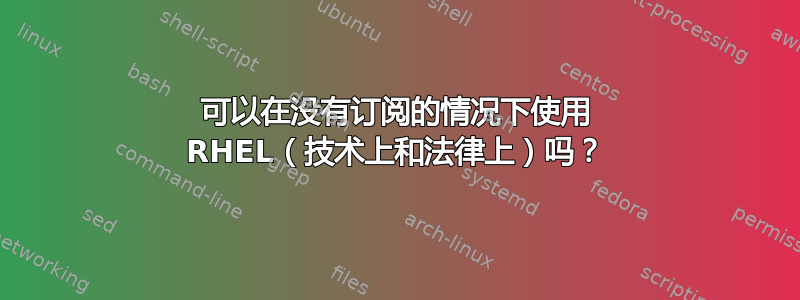
不购买订阅即可运行 RHEL 是否可行且合法?
一些背景
我们的组织已为客户在裸机机器上安装了 3 个 RHEL 盒子,并且已有订阅(到目前为止,这对于红帽来说是一笔相当不错的交易)。
现在似乎需要测试一些设置,这些设置现在应该直接应用于生产系统,但应用于虚拟化系统。鉴于我们想要作为测试,希望系统尽可能与原始系统保持相似,包括在这些机器上运行 RHEL(我知道 CentOS,但目前还不清楚是否有差异,因此使用 CentOS 会引入不希望的差异...)。
鉴于我们(更好地说是我们的客户)已经通过三个服务器订阅为 RHEL 做出了很好的贡献,我想知道技术上是否可以“作弊”,并运行 RHEL 的虚拟机,该虚拟机不会订阅 RHN,而是订阅“本地存储库”/“在我们的 LAN 中”充满了原始服务器从 RHN 加载的软件包。
我可以查询rpm -qa并查看这三台服务器从 RHN 使用的所有软件包,并且我确信可以复制 rpm 文件,并且我假设它createrepo是一个设置绳索的工具,我可以httpd在虚拟机的本地主机上托管该绳索机器网络。所以我认为这在技术上是完全可能的,这个问题只是需要一些确认(充其量,当然也许这是不可能的,这也是这个问题的结果)
第二个方面更多的是法律性质。如果它是专有产品,例如微软的优秀软件(为了举例),我会意识到,如果没有获得许可,我将无能为力。然而,我假设 RH 分发的大多数软件包(??所有?)都具有某种健康的 GPLv2 感染,因此允许任何人(从 RHEL 获得许可)拥有重新许可的自由软件权利。
假设我们的客户订阅了 RHN,提供了大多数软件包的 GPLv2 性质,并且获得了以下自由软件权利,这样的假设是否正确:
- 要求获得 (GPLv2) 的源代码以及他们通过 RHN 收到的其他自由软件许可代码
- 也有权重用他们需要的 RHN 二进制包吗?
由于版权的原因,要合法使用软件,必须获得许可。据我所知,这是在软件包级别上完成的(在 Linux 发行版的上下文中),因为那些上游软件包项目是原始版权所有者(即,它不是创建 bash 的 Red Hat,而是许多贡献者,并且GNU 项目)。为了找出许可证,我运行了以下查询:
rpm -qa | while read pkg; do LANG=C yum info "$pkg" ; done | grep -ie '^License' | sort | uniq -c
产生这些许可证:
1 License : AFL and GPLv2+
3 License : ASL 2.0
4 License : Boost and MIT and Python
25 License : BSD
3 License : BSD and GPLv2+
2 License : BSD and LGPLv2 and Sleepycat
1 License : BSD with advertising
1 License : BSD with advertising and MPLv1.1
2 License : CC-BY-SA
1 License : commercial
2 License : Commercial
2 License : Commercial IBM
1 License : (FTL or GPLv2+) and BSD and MIT and Public Domain and zlib with
1 License : GPL
5 License : GPL+
1 License : GPL+ and BSD and GPLv2+ and GPLv2 and LGPLv2+
1 License : GPL+ and GPLv2 and GPLv2+ and GPLv3+ and LGPLv2+
1 License : GPL+ and GPLv2+ and MIT and Redistributable, no modification
1 License : GPL+ and LGPLv2+
27 License : GPL+ or Artistic
1 License : (GPL+ or Artistic) and BSD
1 License : (GPL+ or Artistic) and (GPLv2+ or Artistic) and Copyright Only and
37 License : GPLv2
48 License : GPLv2+
3 License : GPLv2+ and BSD
1 License : GPLv2+ and GPL+
1 License : GPLv2 and GPLv2+ with exceptions and GPLv3+ and Verbatim and
2 License : GPLv2+ and GPLv3+
1 License : GPLv2 and LGPLv2
5 License : GPLv2+ and LGPLv2+
2 License : GPLv2+ and LGPLv2+ with exceptions
1 License : GPLv2+ and Public Domain
1 License : GPLv2+ and Redistributable, no modification permitted
1 License : GPLv2+, LGPLv2+, MIT
2 License : (GPLv2+ or AFL) and GPLv2+
1 License : GPLv2+ or Artistic
1 License : GPLv2+ or LGPLv2+ or MPLv1.1
3 License : GPLv2+ or LGPLv3+
1 License : GPLv2 with exceptions and LGPLv2 and BSD
1 License : GPLv3
22 License : GPLv3+
2 License : (GPLv3+ and ASL 2.0)
1 License : GPLv3+ and GFDL
1 License : GPLv3+ and GFDL and BSD and MIT
1 License : GPLv3+ and GPL and LGPLv3+ and LGPL and BSD
1 License : GPLv3+ and (GPLv2+ or LGPLv3+)
1 License : GPLv3+ and GPLv3+ with exceptions and GPLv2+ and GPLv2+ with
4 License : GPLv3+ and GPLv3+ with exceptions and GPLv2+ with exceptions and
3 License : GPLv3+ and LGPLv2+
1 License : IBM and GPLv2+
3 License : ISC
1 License : LGPL-2.0
12 License : LGPLv2
40 License : LGPLv2+
1 License : LGPLv2+ and GPLv2+ and CC-BY-SA
1 License : LGPLv2+ and GPLv3+
1 License : LGPLv2+ and GPLv3+ and GFDL
1 License : LGPLv2+ and GPLv3+ and GPLv2+ and Verbatim and Public Domain
3 License : LGPLv2+ and LGPLv2+ with exceptions and GPLv2+
1 License : LGPLv2+ and MIT
1 License : LGPLv2+ or MIT
2 License : LGPLv3+
1 License : LGPLv3+ and GFDL
1 License : LGPLv3+ and GPLv3+ and GFDL
1 License : LGPLv3+ or GPLv2+
1 License : Licensed only for approved usage, see COPYING for details.
22 License : MIT
2 License : MIT and BSD and ISC and GPLv2+
1 License : MIT and Public Domain
1 License : MIT or LGPLv2+ or BSD
1 License : MPLv1.1
6 License : MPLv2.0
1 License : OpenLDAP
1 License : OpenSSL
1 License : Proprietary
11 License : Public Domain
5 License : Python
1 License : Python or ZPLv2.0
15 License : Redistributable, no modification permitted
4 License : Vim
1 License : zlib and Boost
现在,尽管要了解所有的特殊性很麻烦,但我认为那些“自由软件许可证”(即 GPLv2+)的许可证应该赋予获得许可证的人简单地生成尽可能多的此类 rpm 副本的权利。他们请吗?
我不太确定 MIT 或 BSD 软件,我认为 Red Hat 能够要求软件许可证才能使用软件包?
答案1
出于测试目的,您应该获得免费的开发人员订阅,您可以通过该订阅获得红帽开发者网站。
否则,您将必须仔细审查客户与红帽的合同;它准确地涵盖了您可以做什么和不能做什么。
答案2
注意!这不是法律建议
是的,您可以安装并运行 RHEL,因为操作系统本身是免费的。您支付的费用是订阅。
关于包的重用 - 这是非常特殊的情况,您可能无权使用它们,因为它们来自特定的订阅并针对特定的机器。但也许 Layer 可以更好地回答这一点。
您可以创建本地存储库(合法的存储库),但只能使用从 RHEL 下载的媒体中的软件包(和精确版本)。


